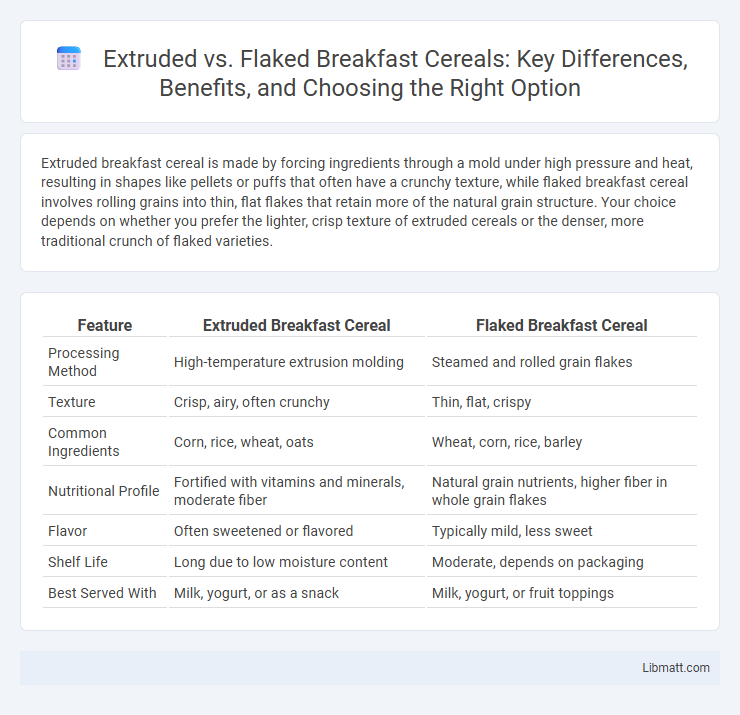Extruded breakfast cereal is made by forcing ingredients through a mold under high pressure and heat, resulting in shapes like pellets or puffs that often have a crunchy texture, while flaked breakfast cereal involves rolling grains into thin, flat flakes that retain more of the natural grain structure. Your choice depends on whether you prefer the lighter, crisp texture of extruded cereals or the denser, more traditional crunch of flaked varieties.
Table of Comparison
| Feature | Extruded Breakfast Cereal | Flaked Breakfast Cereal |
|---|---|---|
| Processing Method | High-temperature extrusion molding | Steamed and rolled grain flakes |
| Texture | Crisp, airy, often crunchy | Thin, flat, crispy |
| Common Ingredients | Corn, rice, wheat, oats | Wheat, corn, rice, barley |
| Nutritional Profile | Fortified with vitamins and minerals, moderate fiber | Natural grain nutrients, higher fiber in whole grain flakes |
| Flavor | Often sweetened or flavored | Typically mild, less sweet |
| Shelf Life | Long due to low moisture content | Moderate, depends on packaging |
| Best Served With | Milk, yogurt, or as a snack | Milk, yogurt, or fruit toppings |
Introduction to Breakfast Cereals
Extruded breakfast cereals are made by forcing ingredients through a shaped die under high pressure and temperature, resulting in puffed or shaped pieces with a crunchy texture. Flaked breakfast cereals are produced by rolling cooked grains into thin, flat flakes that retain more of the grain's original structure and offer a lighter crunch. Your choice between extruded and flaked cereals impacts texture, nutritional profile, and flavor absorption in your morning meal.
What Are Extruded Breakfast Cereals?
Extruded breakfast cereals are produced by forcing a moistened cereal dough through a shaped die under high pressure and temperature, resulting in various shapes and textures. This process allows for uniform cooking, enhanced flavor absorption, and a crunchy texture distinct from flaked cereals, which are typically made by rolling grains into thin flakes. Extrusion also enables the incorporation of added nutrients and flavors, creating versatile and shelf-stable breakfast options.
What Are Flaked Breakfast Cereals?
Flaked breakfast cereals consist of grains that have been cooked, rolled, and toasted into thin, crisp flakes, preserving the natural texture and flavor of the whole grain. Common examples include corn flakes and bran flakes, which maintain a light, airy texture ideal for milk absorption without becoming soggy quickly. These cereals typically retain more of the grain's original structure compared to extruded cereals, offering higher fiber content and a mild, natural taste.
Manufacturing Processes: Extrusion vs Flaking
Extruded breakfast cereals undergo a high-temperature, high-pressure process where ingredients are mixed, cooked, and shaped through a die, resulting in puffed, crunchy textures with uniform shapes. Flaked breakfast cereals are produced by steaming cereal grains and then flattening them between rollers to create thin, crisp flakes that retain more of the grain's original texture and nutrients. Your choice between extruded and flaked cereals depends on desired texture and nutritional preferences driven by these distinct manufacturing processes.
Nutritional Differences: Extruded vs Flaked Cereals
Extruded breakfast cereals often contain higher levels of added sugars and artificial ingredients due to the high-temperature processing method, which can reduce some nutrients. Flaked cereals typically retain more natural fiber and vitamins because they undergo a gentler steaming and rolling process. When choosing your breakfast cereal, consider the nutritional profiles, as flaked cereals usually offer a more wholesome option with fewer additives.
Texture and Taste Comparison
Extruded breakfast cereal features a denser, crunchier texture due to the high-pressure cooking process, delivering a more intense, toasted flavor profile. Flaked breakfast cereal offers a lighter, crispier bite with a subtle sweetness and a more delicate taste from its gentle toasting method. Your preference may depend on whether you enjoy a robust crunch or a tender, airy crispness in your morning meal.
Popular Brands: Extruded and Flaked Cereals
Popular extruded breakfast cereals include brands like Kellogg's Froot Loops and General Mills' Trix, known for their colorful, shaped, and puffed textures. Flaked cereals, such as Kellogg's Corn Flakes and Frosted Flakes, offer a thin, crispy texture derived from toasted corn or wheat flakes. Both types dominate the breakfast market, catering to different preferences with extruded cereals often emphasizing playful shapes and flavors, while flaked cereals focus on a classic, crunchy experience.
Consumer Preferences and Trends
Consumer preferences for extruded breakfast cereals tend to favor texture variety, with products offering puffed or crunchy shapes that appeal to children and adults alike. Flaked cereals often attract health-conscious consumers who prioritize whole grain content and lower sugar levels, aligning with trends toward cleaner labels and natural ingredients. Your choice between extruded and flaked cereals should consider these preferences, as well as evolving market trends emphasizing sustainability and functional benefits like added vitamins and fiber.
Health Considerations and Additives
Extruded breakfast cereals often contain higher levels of added sugars, artificial flavors, and preservatives compared to flaked cereals, which can impact overall health negatively if consumed in excess. Flaked cereals typically undergo minimal processing, retaining more natural nutrients and fiber, contributing to better digestion and sustained energy release. Choosing cereals with whole grains, low sugar content, and minimal additives is crucial for maintaining a balanced diet and supporting cardiovascular health.
Choosing the Right Cereal for Your Diet
Extruded breakfast cereals are processed under high pressure and temperature, resulting in a puffed texture often fortified with vitamins and minerals, making them suitable for those seeking nutrient-dense options with controlled portions. Flaked breakfast cereals, typically made by rolling grains into thin sheets and toasting them, retain more of the grain's original texture and fiber, which supports digestive health and sustained energy release. Selecting between extruded and flaked cereals depends on dietary goals like fiber intake, caloric control, and nutrient enrichment preferences.
extruded breakfast cereal vs flaked breakfast cereal Infographic

 libmatt.com
libmatt.com